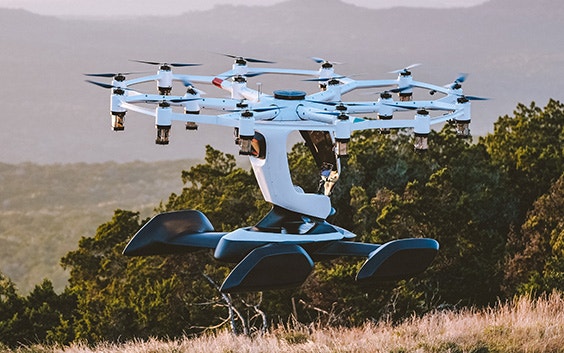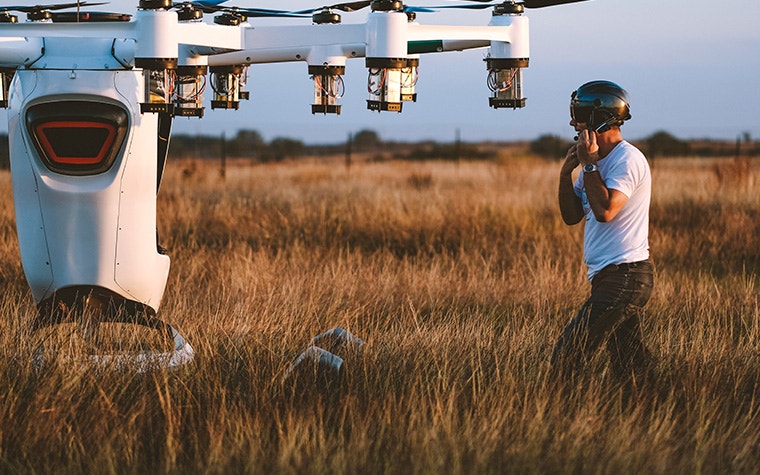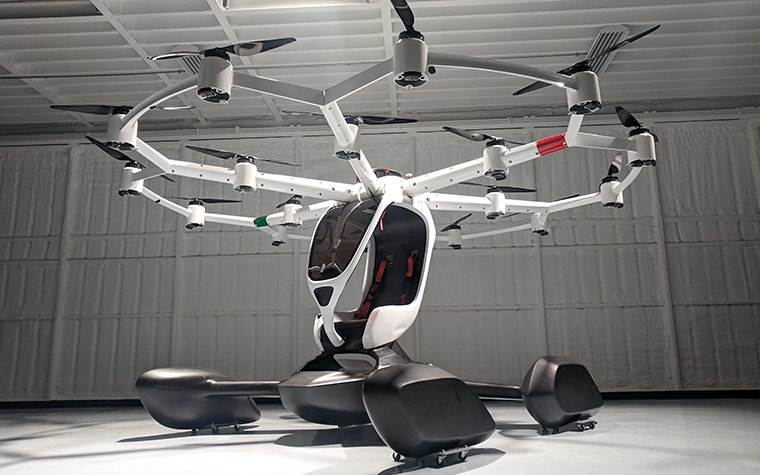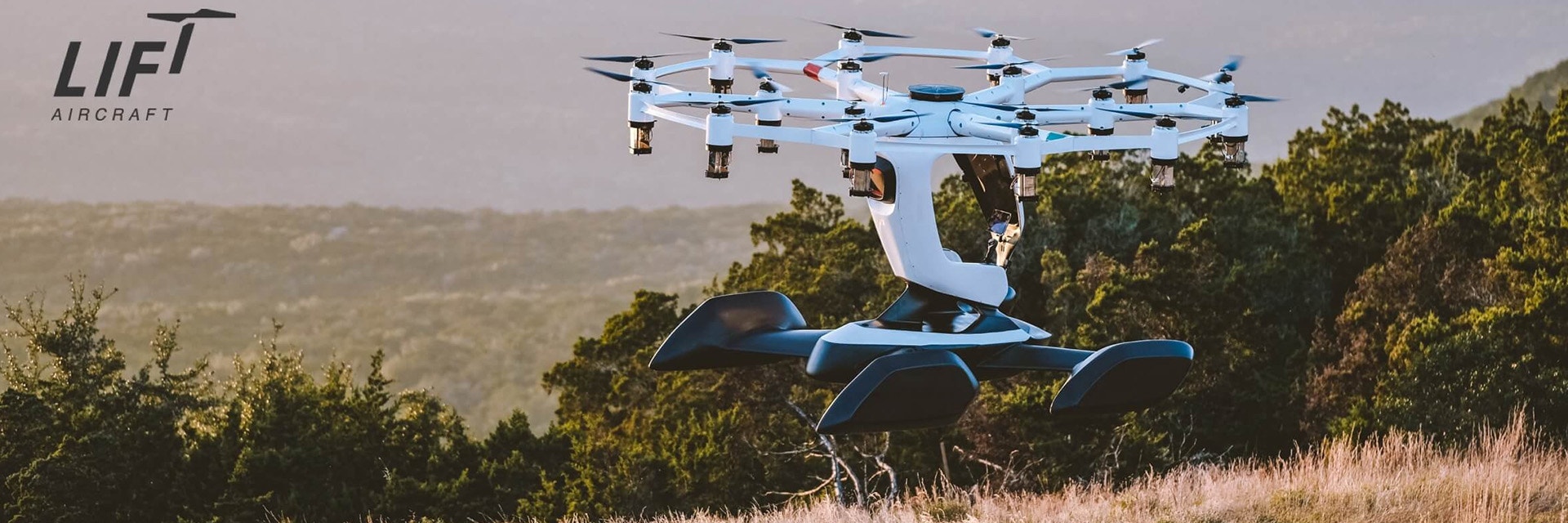
INTERVIEW
3DP&Me: LIFT Takes off with Help from 3DP
LIFT Aircraft Inc. is a US-based eVTOL business with a global team and a simple mission: to make the experience of piloting accessible to anybody. The team around CEO Matt Chasen has been using cutting-edge technology from batteries to materials, from generative design to additive manufacturing, to go from a blank piece of paper to manned flight in less than 13 months. We talk to Matt, Chief Engineer Balazs Kerulo, and Charles Justiz, a former NASA Test Pilot, about the role 3D printing has played in their journey so far and how they keep finding the right balance between fast and safe.
Matt, maybe you could start by telling us about your vision with LIFT?
Matt Chasen: Our vision is simple. We want to bring the experience of flight within reach of ordinary people. At the moment, flying an aircraft is a very expensive experience that is open to very few people. Becoming a pilot involves a huge amount of training and the cost of using an aircraft is high too.
We want to change that by taking all of the skill out of it, by leveraging autonomy, by using safe and simple distributed electric propulsion. We can let people enjoy the experience of flight without the hassle while still being safe.
What you’ve listed there — autonomy, electric propulsion — and some of the other technologies we’ll talk about, they’re all fairly new and scary for an industry as safety-conscious as aviation!
Matt: They are scarily new. That’s why we’re taking a very measured, methodical approach to them. For example, we’re using semi-autonomous flight control, not full autonomy. The human in the loop is still the best sensor. Even an untrained pilot can ‘sense and avoid.
We’re using these new technologies, but sensibly. Because without them, we couldn’t do what we are doing. A lot of different technologies have matured and lined up to make right now exactly the right time for this type of business. 3D printing is one of them — we couldn’t have done any of this without the time-to-market advantages of 3D printing.
“We couldn’t have done any of this without the time-to-market advantages of 3D printing.”
And you started out with a clear business model straightaway. This was not a mad inventor-type idea — you had a clear strategy to take this into serial production.
Matt: That’s right. We didn’t just set out on a ten-year R&D project. We looked for a real business opportunity first. What we found was this regulatory class in the US called ‘ultra-light aircraft’. The challenge is to conform to the weight restrictions of that class. And we’ve done it through weight optimization from 3D printing and other technologies. It allowed us to go to market without certification from EASA — and there’s not even a pilot license required! In terms of our mission to democratize flight, it’s just perfect.
You got to your first prototype incredibly fast. Are you planning on keeping that up?
Matt: Yes! We used 3D printing to basically iterate an aircraft from a blank sheet of paper to a manned flight in just over a year. We did that by 3D printing many of the parts required for our different prototypes that then very quickly evolved into one of the very first production eVTOL aircraft in the world.
And we do want to keep up that pace. Typically, in aviation, with certified aircraft, you have extremely long product cycles. Because once you’ve developed and certified something, it’s so incredibly laborious and expensive to change that or do something new. So you just keep doing the same thing. Aviation has been really held back from advancing because of this.
Other industries are reinventing and iterating, and you see product cycles in technology that are much faster! Because certification is not required, we can aim for product cycles that are much closer to what we see in the tech sector. We’re aiming for a cycle of 2-3 years, instead of 20-30 years, which is what’s typical now in the aviation industry. And part of what enables that is 3D printing.
With additive manufacturing, you don’t have to invest in huge quantity orders that require molds and all that expensive stuff that only makes sense if you need tens of thousands of something. If we’re only going to make a thousand of something, it’s much more economical to 3D print. And then it’s also quicker, so we can iterate faster, and that next version can come out much sooner.
But you used 3D printing not just for speed, but also for light weighting, to stay in that ultralight category.
Matt: That’s right. We are super-focused on weight. If we’re overweight, we’re out of business. So it comes down to leveraging titanium and other 3D-printed metals. I’ll let Balazs, our chief engineer, talk a bit more about what we’ve made possible here. He used approaches like generative design to come up with superlight structures that are just not possible without 3D printing technology.


Balazs, you got your head round 3D printing very quickly and then really went for it. Tell us about your learning curve.
Balazs Kerulo: Prior to LIFT, I used to design conventional fixed wing aircraft below specific weight limits, which was very challenging. Back then, we didn’t have 3D printing available, so I was forever blaming the manufacturing technologies for constraining us as designers too much and not letting me do what I wanted to do.
That meant I was kind of primed in favor of any new technology that would get rid of some of those constraints. So the first thing I did when 3D printing came along was to get myself a home 3D printer to play with — with my son, who was maybe four at the time. Now he’s ten and can 3D print his own stuff already.
By the time we all got together with Matt to talk about this crazy plan to get to a flight-ready aircraft in just over a year, the first thing I started thinking about was how we can use new enabling technologies, new manufacturing technologies to evolve designs really fast. We got the Materialise team involved really early on for that reason. At the same time, I started looking at software that could do generative design — to come up with lots of design options within certain constraints that we’d then refine further. Generative design pairs very well with 3D printing, because — like 3DP — it doesn’t really care about the old constraints of traditional manufacturing processes either.
You’re particularly proud of the design of a particular part, the pylon. Why is the part important and what has 3DP allowed you to do with it?
Balazs: We’ve got a distributed powertrain. That means we have 18 motors and 18 batteries. Which is great for safety, but also means that everything, any part to do with the powertrain has to be multiplied by 18. Every gram is multiplied by 18. So we have to be very efficient with the design of those parts in particular.
The pylon is probably the most important of them all. It connects the motor to the aircraft. All the forces run through it. It was a challenge to design it to withstand all the forces, the torque, the dynamic forces, etc. It was one of the first parts we started working on and that we used generative design for. We chose titanium for that part and then used a material-defined, generative design process to develop it.
Generative design was really handy here, because we only had to tell it the constraints — the forces, the torque and fatigue characteristics we were aiming for. The computer came up with a really good solution straightaway that we liked and that worked. And that structure could really only be made using 3D printing.
Because the manufacturing technology is so new, we use very high factors of safety. The safety factor we applied to this part is around 10. The part is very light and it could be slimmed down even further, but we want to stick with that high safety factor for now. We’re doing fatigue testing with that part at the moment and, if the results are good, we could go lower. But then, the parts are so light already that maybe we should just leave them as they are, knowing that we could reduce them down further if we ever wanted to.
How important was it to have a partner like Materialise on this, how much of their help did you use?
Balazs: We came up with the part and sent it to the Materialise team and they came back and said ‘that’s fine, that’s printable’, but they also made suggestions like ‘use a diamond shape here to make it quicker and more environmentally friendly and cheaper to print’, etc. And that’s really how we’ve been working with the team ever since. We send our parts and the feedback that comes back is very constructive and has really helped us refine designs.
Having gone through that exercise of getting from an idea to a market-ready product so quickly and having used AM quite heavily to get there, what advice would you give people looking to pull off something similar?
Balazs: My advice would be not to be afraid of it. Even using higher factors of safety, find that parts are lighter and more efficient than anything you could make conventionally.
Maybe at this point we should bring in Charles to ask him how he as a test pilot feels about all this. Let’s start with that safety factor — 10 is really, really high for aviation.
Charles Justiz: Ten is pretty high. But we need it because we’re very light, so if we wanted to go with a lower factor of safety, we’d have to beef up the structure in other places to reduce vibration and the susceptibility to body bending — and then you’d suddenly have a heavier vehicle. We’re looking at risk, at cost and at weight here.
You’ve been looking at all this with a test pilot’s eye. Where have you seen the biggest value of 3D printing in the process?
Charles: Ease of construction is something people always cite as a key benefit of 3D printing, but it’s actually ease of reconstruction! If you have a prototype vehicle and you go, ‘Oops, that didn’t go well. The load distribution is not what I expected; the torsion is not what I expected; I hit turbulence and the vehicle shook this way and that’s not acceptable,’ — you have to redo it! Then you can wait six months because you have to make a new mold to pour the part in or you can go, ‘Here’s the new spec, CAD/CAM looks good, it fits the need — please print that for me.’ And in 99.9% of cases you get a part back that meets your spec exactly. That’s an enormous advantage in rapid prototyping.
When you first started working on this type of aircraft, from a pilot’s perspective, is this scary or are you looking at it from an engineering perspective at the same time and are reassured by the factor of safety and the process? What is it you worry about as a pilot when you look at a structure like this, that has been made using completely new technologies?
Charles: What you look at is risk. And everything carries a risk. What we have to do is quantify the risk and ask what level of risk is acceptable. Then we work through that and identify where a risk is unacceptable, we beef up the factor of safety in a particular place.
I’m a test pilot and at NASA I flew research vehicles. One of a kind, totally redesigned aircraft. What I’d do is imagine scenarios to put the craft through and say, ‘Have you considered this happening?’ And we’re doing exactly the same at LIFT. We’ve talked about a generative design philosophy, but there’s also a generative design philosophy to flight test.


And the purpose of testing is to see what nasty, extreme loads you can create and how comfortably they are within your factor of safety?
Charles: Yes, but you don’t do it all at once. You do it very carefully, very slowly. We’ll fly the vehicle in hover, unoccupied. Then we’ll move the vehicle at certain speed. That’s all written down. And we have requirements we have to hit before we move on to the next step. And we’ll go back through the data and look at what we have done to the vehicle in that test.
The reason we do this and the reason we have this factor of safety is because these new structures, materials and components have different fatigue behavior, respond differently to vibration and wear differently. Conventional metal parts will give way slowly and build cracks first, so they kind of warn you. Other materials don’t, they just go. And we want to make sure we’re nowhere close to that.
This iterative and methodical approach seems to be engrained in all three of you. It all has a fast-paced but also very careful feel to it. It’s a measured approach.
Charles: We’re very fast and very careful. Which is very hard!
Matt: And that all goes back to our overall philosophy, which is all about safety. At the very beginning, I challenged Balazs to, first of all, meet the ultralight category, but from there we optimized our design entirely for safety. We didn’t for example have any requirement to fly at any rate of speed.
We’re not trying to get you places quickly. We’re optimizing for the experience of flying in hover and to go fast enough to do certain things. Others in the eVTOL industry try to do two things well and that’s really hard. To fly on wings but also take off and land vertically. If you add wings, those wings are just dead weight in hover and they reduce your factors of safety.
Our approach really was to just make the safest aircraft possible and we weren’t worried about performance or cost.
That’s really interesting in the context of the technologies you’re using. It gives you a really clear direction and explains the methodical, systematic approach.
Matt: What we’re doing is crazy. But we’ve got a great responsibility. We’re going to be the first to launch a service where people can fly ultralight aircraft that are electric with vertical take-off and landing. We take that responsibility really seriously.
Safety runs through the design choices, the manufacturing technologies, and everything else. Our mission from the outset has been about access, so it just makes perfect sense to go for safety first. Because every bit of risk that you add needs to be matched by skill, which then excludes people, which is exactly what we’re trying to avoid.
Balazs: We’re not going launch something until we know for sure that we can offer a safe and fascinating, but first and foremost safe, experience to people. That’s the point at which we’ll have truly democratized flight.
Matt, Balazs, Charles, thank you for your time!
Share on:

Biography
Matt Chasen, CEO and Founder, LIFT Aircraft
You might also like
Never miss a story like this. Get curated content delivered straight to your inbox.
